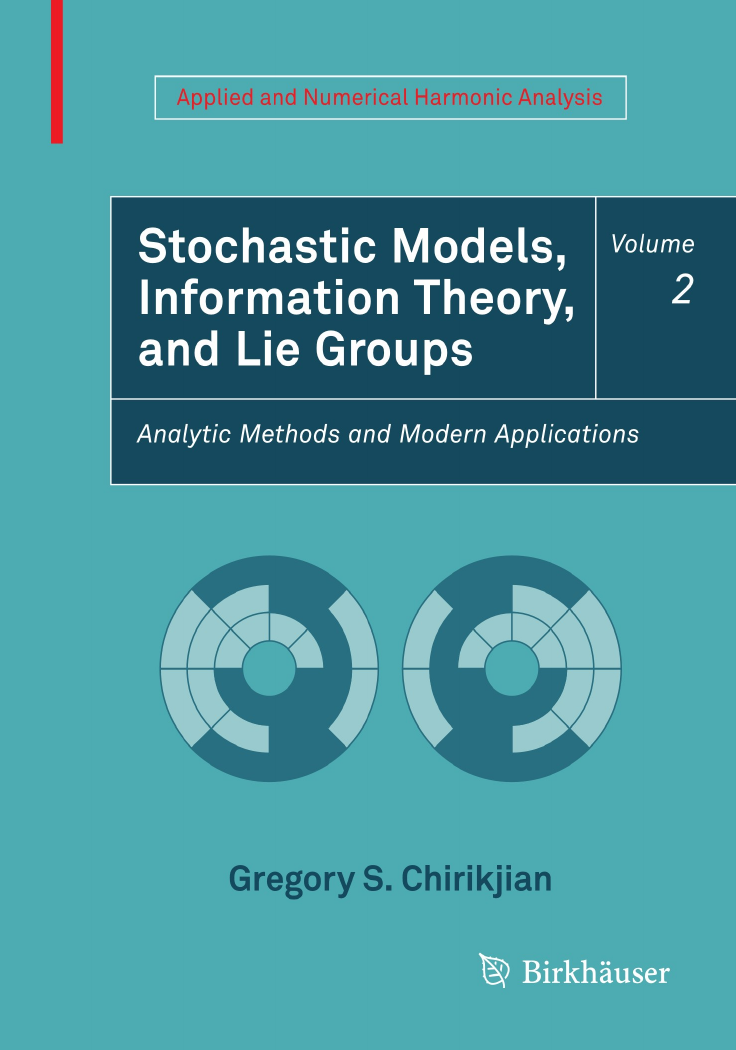�
Gitta Kutyniok
Technische Universität Berlin
Berlin, Germany
Zuowei Shen
National University of Singapore
Singapore
AppliedandNumericalHarmonicAnalysisSeriesEditorJohnJ.BenedettoUniversityofMarylandCollegePark,MD,USAEditorialAdvisoryBoardAkramAldroubiVanderbiltUniversityNashville,TN,USAAndreaBertozziUniversityofCaliforniaLosAngeles,CA,USADouglasCochranArizonaStateUniversityPhoenix,AZ,USAHansG.FeichtingerUniversityofViennaVienna,AustriaChristopherHeilGeorgiaInstituteofTechnologyAtlanta,GA,USAStéphaneJaffardUniversityofParisXIIParis,FranceJelenaKovaˇcevi´cCarnegieMellonUniversityPittsburgh,PA,USAMauroMaggioniDukeUniversityDurham,NC,USAThomasStrohmerUniversityofCaliforniaDavis,CA,USAYangWangMichiganStateUniversityEastLansing,MI,USA�
Stochastic Models,
Information Theory,
and Lie Groups,
Volume 2
Analytic Methods and Modern Applications
Gregory S. Chirikjian�
ISBN 978-0-8176-
-2
DOI 10.1007/978-0-8176-
Springer New York Dordrecht Heidelberg London
4944-9
4943
e-ISBN 978-0-8176-
4944-9
Library of Congress Control Number:
2011941792
Mathematics Subject Classification
94A15, 94A17
(2010): 2E60, 53Bxx, 53C65, 58A15, 58J65, 60D05, 60H10, 70G45, 82C31,
2
© Springer Science+Business Media, LLC 2012
All rights reserved. This work may not be translated or copied in whole or in part without the written permission of
the publisher (Birkhäuser Boston, c/o Springer Science+Business Media, LLC, 233 Springer Street, New York, NY
10013, USA), except for brief excerpts in connection with reviews or scholarly analysis. Use in connection with
any form of information storage and retrieval, electronic adaptation, computer software, or by similar or dissimilar
methodology now known or hereafter developed is forbidden.
The use in this publication of trade names, trademarks, service marks, and similar terms, even if they are not identified
as such, is not to be taken as an expression of opinion as to whether or not they are subject to proprietary rights.
Printed on acid-free paper
Springer is part of Springer Sc
ience+Business Media (www.birkhauser-science.com)
Gregory S. ChirikjianDepartment of Mechanical EngineeringThe Johns Hopkins UniversityBaltimore, MD 21218-2682USAgregc@jhu.edu�
Tomyfamily�
�
ANHASeriesPrefaceTheAppliedandNumericalHarmonicAnalysis(ANHA)bookseriesaimstoprovidetheengineering,mathematical,andscientificcommunitieswithsignificantdevelopmentsinharmonicanalysis,rangingfromabstractharmonicanalysistobasicapplications.Thetitleoftheseriesreflectstheimportanceofapplicationsandnumericalimplementation,butrichnessandrelevanceofapplicationsandimplementationdependfundamentallyonthestructureanddepthoftheoreticalunderpinnings.Thus,fromourpointofview,theinterleavingoftheoryandapplicationsandtheircreativesymbioticevolutionisaxiomatic.Harmonicanalysisisawellspringofideasandapplicabilitythathasflourished,de-veloped,anddeepenedovertimewithinmanydisciplinesandbymeansofcreativecross-fertilizationwithdiverseareas.Theintricateandfundamentalrelationshipbe-tweenharmonicanalysisandfieldssuchassignalprocessing,partialdifferentialequa-tions(PDEs),andimageprocessingisreflectedinourstate-of-the-artANHAseries.Ourvisionofmodernharmonicanalysisincludesmathematicalareassuchaswavelettheory,Banachalgebras,classicalFourieranalysis,time-frequencyanalysis,andfractalgeometry,aswellasthediversetopicsthatimpingeonthem.Forexample,wavelettheorycanbeconsideredanappropriatetooltodealwithsomebasicproblemsindigitalsignalprocessing,speechandimageprocessing,geophysics,patternrecognition,biomedicalengineering,andturbulence.Theseareasimplementthelatesttechnologyfromsamplingmethodsonsurfacestofastalgorithmsandcom-putervisionmethods.TheunderlyingmathematicsofwavelettheorydependsnotonlyonclassicalFourieranalysis,butalsoonideasfromabstractharmonicanalysis,includ-ingvonNeumannalgebrasandtheaffinegroup.ThisleadstoastudyoftheHeisenberggroupanditsrelationshiptoGaborsystems,andofthemetaplecticgroupforamean-ingfulinteractionofsignaldecompositionmethods.Theunifyinginfluenceofwavelettheoryintheaforementionedtopicsillustratesthejustificationforprovidingameansforcentralizinganddisseminatinginformationfromthebroader,butstillfocused,areaofharmonicanalysis.ThiswillbeakeyroleofANHA.Weintendtopublishwiththescopeandinteractionthatsuchahostofissuesdemands.Alongwithourcommitmenttopublishmathematicallysignificantworksatthefrontiersofharmonicanalysis,wehaveacomparablystrongcommitmenttopublishmajoradvancesinthefollowingapplicabletopicsinwhichharmonicanalysisplaysasubstantialrole:vii�
















 2023年江西萍乡中考道德与法治真题及答案.doc
2023年江西萍乡中考道德与法治真题及答案.doc 2012年重庆南川中考生物真题及答案.doc
2012年重庆南川中考生物真题及答案.doc 2013年江西师范大学地理学综合及文艺理论基础考研真题.doc
2013年江西师范大学地理学综合及文艺理论基础考研真题.doc 2020年四川甘孜小升初语文真题及答案I卷.doc
2020年四川甘孜小升初语文真题及答案I卷.doc 2020年注册岩土工程师专业基础考试真题及答案.doc
2020年注册岩土工程师专业基础考试真题及答案.doc 2023-2024学年福建省厦门市九年级上学期数学月考试题及答案.doc
2023-2024学年福建省厦门市九年级上学期数学月考试题及答案.doc 2021-2022学年辽宁省沈阳市大东区九年级上学期语文期末试题及答案.doc
2021-2022学年辽宁省沈阳市大东区九年级上学期语文期末试题及答案.doc 2022-2023学年北京东城区初三第一学期物理期末试卷及答案.doc
2022-2023学年北京东城区初三第一学期物理期末试卷及答案.doc 2018上半年江西教师资格初中地理学科知识与教学能力真题及答案.doc
2018上半年江西教师资格初中地理学科知识与教学能力真题及答案.doc 2012年河北国家公务员申论考试真题及答案-省级.doc
2012年河北国家公务员申论考试真题及答案-省级.doc 2020-2021学年江苏省扬州市江都区邵樊片九年级上学期数学第一次质量检测试题及答案.doc
2020-2021学年江苏省扬州市江都区邵樊片九年级上学期数学第一次质量检测试题及答案.doc 2022下半年黑龙江教师资格证中学综合素质真题及答案.doc
2022下半年黑龙江教师资格证中学综合素质真题及答案.doc